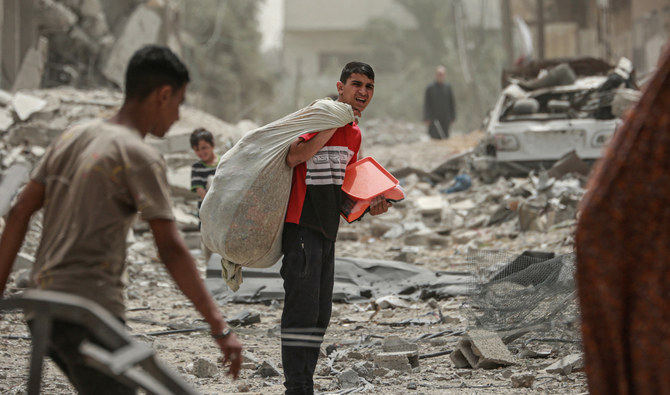
As Iran’s economy continues to decline, many Iranians are struggling to make ends meet, unemployment and inflation are at a record high, and more people have become disaffected with the Islamic Republic. In the midst of this unprecedented crisis, Supreme Leader Ali Khamenei is resorting to, and doubling down on, his tried and tested modus operandi: Dodging responsibility.
Khamenei uses several scapegoats to avoid accountability. His most important strategy is blaming the West, specifically the US, for the country’s financial problems. In his latest televised speech on the occasion of Eid Al-Adha last week, Khamenei again pointed a finger at Washington, saying: “US sanctions have undoubtedly created problems for Iran.”
After the Trump administration pulled out of the Joint Comprehensive Plan of Action, aka the Iran nuclear deal, and reimposed sanctions, Iran’s oil exports fell significantly. Tehran used to sell about 2.5 million barrels per day (bpd), but it is now exporting only about 70,000 bpd. But many of Iran’s economic problems existed before the US adopted its maximum pressure policy.
Corruption in Iran is ingrained in the political and financial institutions that are the country’s backbone. Embezzlement and money laundering within the banking system are prime examples of corruption. Politicians across the political spectrum, including members of the president’s office, have been known to engage in corrupt practices for their own political and financial benefit. Corruption often takes place by granting loans, financial benefits and fellowships to relatives of senior officials or those who show loyalty.
For example, Hossein Fereydoun — the brother of Iranian President Hassan Rouhani and a member of the Moderation and Development Party, who was formerly in charge of the supreme leader’s security — was last year sentenced to five years in prison for participating in a large-scale bribery scheme. In 2018, Ahmad Araqchi, a former deputy governor of the central bank and a relative of Deputy Foreign Minister Abbas Araqchi, and Meysam Khodaei, who was an adviser to Mohammad Nahavandian, Rouhani’s deputy for economic affairs, were exposed for their involvement in a corruption case worth nearly $200 million. In December 2017, Hamid Baghaei, a former vice president and confidant of ex-President Mahmoud Ahmadinejad, was indicted on corruption charges, including embezzlement, and reportedly given a 63-year jail term. And the billionaire Babak Zanjani was convicted for embezzling $2.7 billion from a government-owned petroleum company in 2013. These are only a few examples of the corruption that has sparked anger in Iranian society.
There are rare occasions when corruption cases are brought to court not as part of a concerted effort to fight graft in Iran, but instead as a regime facade to alleviate the people’s frustrations over the economic difficulties they face, which are exacerbated by corruption. Normally, such cases are closed or the sentences are kept secret after months of trial with no legal explanations. These cases can also be due to political disagreements between factions and thereby used as a tool to score political points.
Many people are enraged by the extravagant lifestyles enjoyed by the children of the elite — or the “noble-born,” known as “aghazadeh” — and their families, while ordinary people are struggling to feed their children or send them to school. Instagram channels such as “Rich Kids of Tehran” show images of the elite flaunting their wealth and enjoying lavish lifestyles at home and abroad.
Khamenei, the unelected leader of Iran, has a financial empire worth at least $95 billion, according to a report published by Reuters in 2013. A more recent estimate saw the US Embassy in Baghdad put Khamenei’s worth at nearly $200 billion. It wrote in a 2019 Facebook post: “The possessions of the current supreme leader Ali Khamenei alone are estimated at $200 billion, while many people languish in poverty because of the dire economic situation in Iran after 40 years of rule by the mullahs.”
The regime has failed to enforce article 142 of its own constitution, which states: “The wealth of the leader, the President of the Republic, his deputies, the ministers, and their spouses and children, will be examined by the head of the judiciary before and after their term of office, in order to determine if it is increased illegitimately.”
For almost four decades, the regime has been squandering the nation’s resources on terror and militia groups.
Dr. Majid Rafizadeh
For almost four decades, the regime has been squandering the nation’s resources on terror and militia groups. It is also estimated that more than $100 billion has been spent on its nuclear program. According to a 2013 report released by the Federation of American Scientists, “Iran’s quest for the development of (its) nuclear program has been marked by enormous financial costs and risks. It is estimated that the program’s cost is well over $100 billion, with the construction of the Bushehr reactor costing over $11 billion, making it one of the most expensive reactors in the world.”
Khamenei, who has the final say on Iran’s policies, is the main political figure who should be blamed for the nation’s dire economy.
Dr. Majid Rafizadeh is a Harvard-educated Iranian-American political scientist. Twitter: @Dr_Rafizadeh
Disclaimer: Views expressed by writers in this section are their own and do not necessarily reflect Arab News" point-of-view












